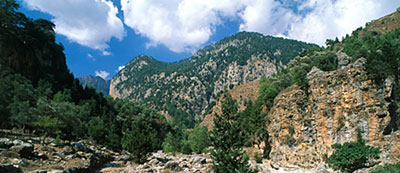 Natural Wonders
Natural Wonders
 Islets of the Greek Islands
Islets of the Greek Islands
Thousands of islets dot the sea around the Greek Islands. Some, such as Néa Kaméni off Santoríni, are uninhabited and volcanic, while others, such as the Diapontian islands off Corfu, have rich vegetation, small communities and great beaches.
 Samariá Gorge, Crete
Samariá Gorge, Crete

Samariá gorge, Crete
A stunning creation of nature, the gorge stretches about 16 km (10 miles) from the Omalós plateau to Agía Rouméli to the south. Towering rock walls have been created over millennia by a river, and at a spot called Iron Gates (Sideróportes), they are only 3 m (10 ft) apart. The gorge is a national park (For further details see Samariá Gorge).
 Blue Caves, Zákynthos
Blue Caves, Zákynthos

Blue Caves, Zákynthos
A rock formation of arches and caverns, the Blue Caves are foremost among the natural wonders of Zákynthos. The sea appears bright blue due to the reflection of the sun between the arches, and contrasts sharply with the white cliffs. Take a boat from Cape Skinári lighthouse for the best views.
 Korissíon Lagoon, Corfu
Korissíon Lagoon, Corfu
This freshwater lagoon is separated from the sea by a narrow stretch of sand dunes and beaches. Enclosed by a forest, it is a natural habitat for wildlife and many bird species, including sandpipers and egrets. Walking beside the lagoon is a magical experience (For further details see Korissíon Lagoon).
 Caves of Sámi, Kefalloniá
Caves of Sámi, Kefalloniá
Melissáni cave and lake is the highlight of an extraordinary network of subterranean waterways and caverns originating at Katavothres, on the other side of the island. It is said to have been the sanctuary of the god Pan and several nymphs, including Melissáni. Nearby is the Drogaráti cave with its famous stalactites and stalagmites (For further details see Caves of Sámi, Kefalloniá).
 Extinct Volcano Polyvótis, Níssyros
Extinct Volcano Polyvótis, Níssyros
This extinct volcano is one of the main attractions of Níssyros. It is around 260 m (860 ft) in diameter and 30 m (100 ft) deep, and surrounded by a grey landscape of craters. Steps lead down to its core. Its last eruption is said to have been over 5,000 years ago.
 Mýrtos Bay, Kefalloniá
Mýrtos Bay, Kefalloniá
One of the foremost sights of Kefalloniá, this bay is famous for its dazzling white-pebble beach formed by fragments from the calcite-rich limestone cliffs that surround it, and its vivid turquoise sea. Mýrtos beach has been voted one of the best in the world (For further details see Mýrtos Bay, Kefalloniá).
 Nydrí Waterfalls, Lefkáda
Nydrí Waterfalls, Lefkáda
These waterfalls, located in the Dimosári gorge, are the most spectacular of the many falls on the island. Cascades of water fall into pools of crystal-clear water, which are popular with swimmers (For further details see Nydrí Waterfalls, Lefkáda).
 Caldera, Santoríni
Caldera, Santoríni
This water-filled cauldron lies off Santoríni and was created in 1450 BC, when a huge volcanic eruption blasted through the once-circular island, creating its current crescent shape. The Néa Kaméni and Palaia Kaméni islands emerged from the water with subsequent volcanic activity, and continue to be volcanic.
 Thérmes Hot Springs, Kos
Thérmes Hot Springs, Kos
These are perhaps the most famous hot springs on the Greek Islands. Thérmes beach is known for its naturally warm pool in the rocks, which is fed by hot springs and is said to have curative powers.